How a Rotary Screw Compressor Works Step by Step
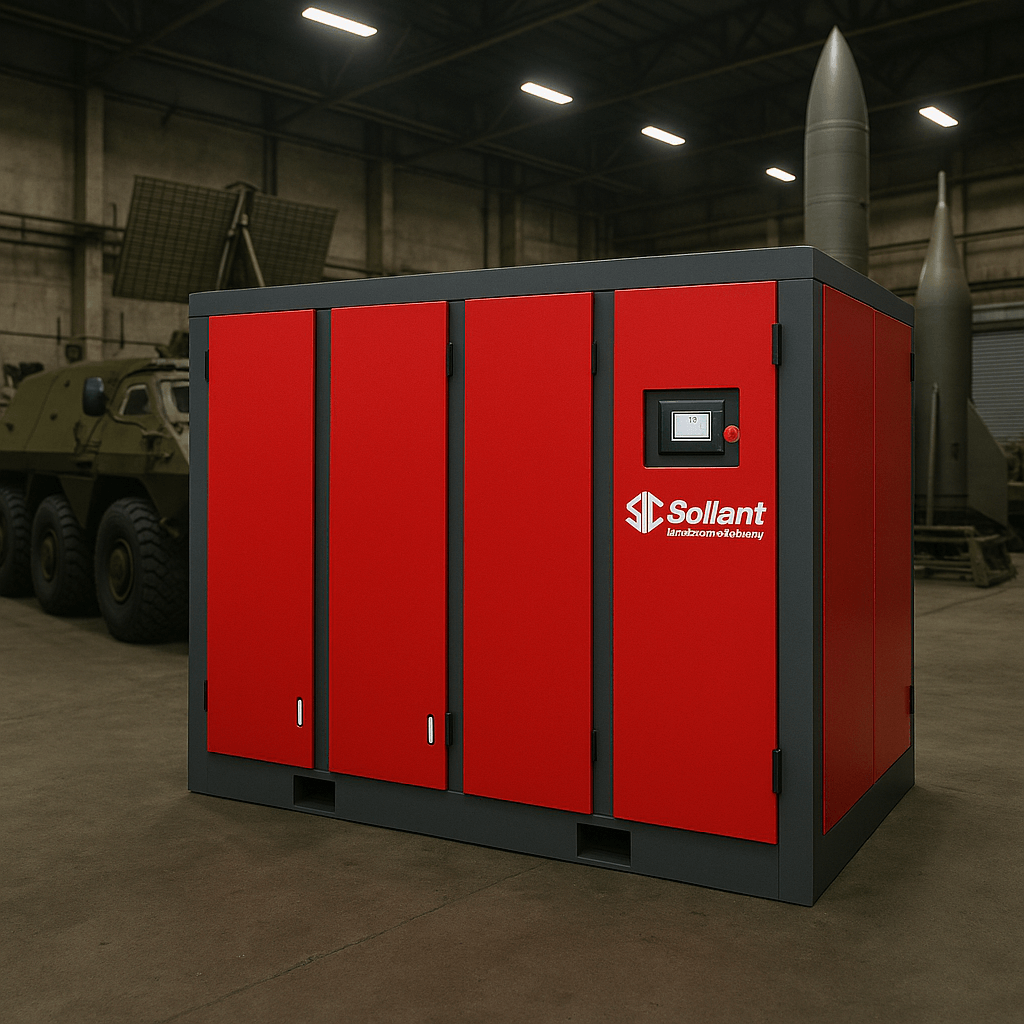
-
Rotary screw compressors are expected to hold a 38.6% share of the industrial air compressor market in 2025.
-
These compressors feature variable speed drives that match output to demand, which helps lower energy consumption.
Table of Contents
Key Takeaways
-
Check the inlet valve regularly. A smooth-operating valve helps your compressor run efficiently and saves energy.
-
Keep your compressor in a cool, dry place. Clean air improves performance and protects internal parts from damage.
-
Use the right type of oil for lubrication. Good oil reduces friction and helps your compressor last longer.
-
Regularly maintain the oil and air separation system. This prevents issues with your tools and ensures clean air output.
-
Choose energy-efficient rotary screw compressors. They save power and reduce costs over time, making them a smart investment.
Air Intake
Inlet Valve
You start with the inlet valve. This part controls how much air enters your screw compressor. When you turn on the compressor, the inlet valve opens wide. It lets in the maximum amount of air. If you stop the compressor, the valve closes. This action prevents air from flowing backward. A good inlet valve helps your compressor work well and saves energy.
Tip: Always check the inlet valve for smooth operation. A faulty valve can lower efficiency and cause problems.
Here are some important facts about the inlet valve:
-
The inlet valve regulates the volume of air entering the compression chamber.
-
It opens fully during loading for maximum air intake.
-
It closes during unloading to prevent backflow.
-
A well-functioning inlet valve keeps your compressor efficient.
Drawing Air In
Once the inlet valve opens, your screw compressor begins to draw air in. The air comes from the surrounding environment. The quality of this air affects how well your compressor works. If the air is hot, it holds less mass. Your compressor must work harder to reach the same pressure. Moist air also makes the cooling system work more.
-
High temperatures reduce air density, so less air enters per cycle.
-
Moisture in hot air strains the cooling system.
-
The compressor may run longer or faster to meet your needs, which uses more energy.
You should keep your compressor in a cool, dry place. This helps it run smoothly and saves power. Clean air also protects the inside parts from damage.
Compression Chamber
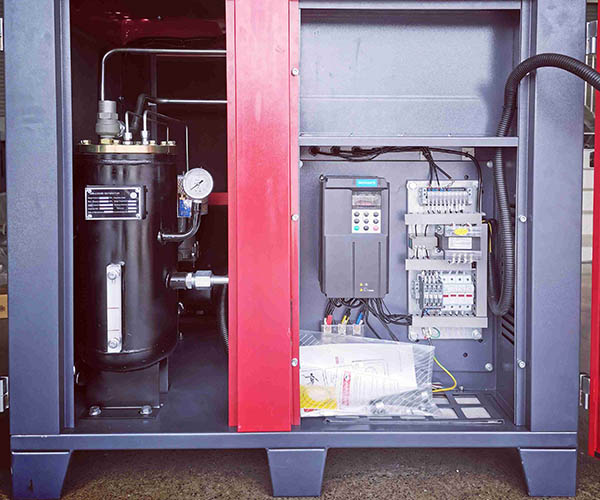
Rotors in a Screw Compressor
You find two main rotors inside the compression chamber: the male rotor and the female rotor. These rotors have helical shapes and fit together like puzzle pieces. The male rotor spins in one direction, while the female rotor turns the opposite way. This movement causes the rotors to intermesh and create small pockets between their threads.
Note: The rotors never touch each other directly. Oil or a thin gap keeps them separated, which reduces wear and helps the machine last longer.
Here are the main components you see in the compression chamber:
-
Air Intake: Air enters through a filter that removes dust and dirt before reaching the chamber.
-
Compression Stage: The rotors trap air between their threads and the chamber walls.
-
Oil Injection: In some models, oil gets injected to seal gaps, lower friction, and absorb heat.
-
Discharge: Compressed air and oil leave the chamber together and move to the next stage.
The design of the screw compressor allows you to get a steady flow of compressed air. The rotors work together to keep the process smooth and continuous.
Air Trapping and Squeezing
When you turn on your screw compressor, the rotors start to spin. As they rotate, they trap air in the spaces between their threads. The air moves along the length of the rotors, getting squeezed into smaller and smaller spaces.
-
As the rotors turn, these chambers shrink in size.
-
The shrinking space forces the air molecules closer together, which increases the air pressure.
This process happens quickly and without pauses. You do not see any pulsing or sudden drops in pressure. The screw compressor keeps the air moving and compressing in a smooth flow.
Tip: If you want your compressor to work efficiently, make sure the rotors stay clean and well-lubricated. Dirt or lack of oil can cause friction and lower performance.
The way the rotors trap and squeeze air is the key to the screw compressor’s high efficiency. You get reliable, pressurized air for your tools and machines.
Oil Injection & Separation
Oil Injection (If Applicable)
You see oil play a big role in many rotary screw compressors. Oil enters the compression chamber and helps your machine run smoothly. Oil cools the system by absorbing heat that builds up during compression. It also lubricates the rotors, which reduces friction and wear. Oil seals small gaps between the rotors, so air does not escape. This makes compression more efficient.
-
Oil lubricates the screw unit for smooth operation.
-
It cools the compressed air to prevent overheating.
-
Oil seals gaps between the rotors to ensure efficient compression.
Tip: Use the right type of oil for your screw compressor. Good oil keeps your machine running longer and helps you avoid costly repairs.
Here is how oil works inside your compressor:
-
Oil is introduced into the compression chamber to cool the system.
-
It lubricates the rotors, reducing friction and wear.
-
Oil seals gaps between the rotors, preventing air escape during compression.
You should know that oil-injected compressors produce more oil vapor, especially in high temperatures. This means you need to check filters often and replace them when needed. Oil-free compressors do not have this problem and require less maintenance.
|
Aspect |
Oil-Injected Compressors |
Oil-Free Compressors |
|---|---|---|
|
Oil Vapor Production |
Produces significantly more oil vapor in high-temperature environments |
Remains unaffected in high temperatures |
|
Maintenance Requirements |
Requires frequent maintenance, posing a risk of production failures due to filter malfunctions |
Eliminates filter replacements and oil management costs, reducing maintenance needs |
Oil and Air Separation
After compression, oil and air mix together. Your compressor uses a special separator to remove oil from the air. The separation process has two main stages: coarse separation and fine separation. Larger oil droplets are easier to separate, while smaller ones need more time and better design.
-
The oil-gas separation process is measured by the residual oil content in the compressed air.
-
Slower gas flow improves separation efficiency.
-
A well-designed separator keeps air pure and lowers maintenance costs.
Note: A well-functioning oil-gas separator helps you avoid problems with your tools and machines.
You need to service the oil and air separation parts regularly. Daily, you should drain condensate and check the oil level. Every three months, clean the air filter and replace the oil filter. Every six months, replace the oil and clean the coolers. Once a year, lubricate motor bearings and inspect electrical systems. The oil separator filter usually lasts about 3,000 hours. Replace it if you see more oil in the air lines or if the pressure drops too much.
|
Interval |
Tasks |
|---|---|
|
Daily/Startup |
Drain condensate; check oil level. |
|
3 Months/500 Hours |
Clean air filter; replace oil filter/oil; inspect connections, belts, safety valves. |
|
6 Months/2,000 Hours |
Replace oil, air filter, oil filter; clean coolers. |
|
12 Months/4,000 Hours |
Lubricate motor bearings; inspect electrical systems. |
|
Oil Separator Filter Replacement |
Lifespan: ~3,000 hours (varies with oil quality and contamination). Replacement triggers include increased oil content in air lines and pressure drop exceeding 0.12 MPa. |

Cooling & Delivery
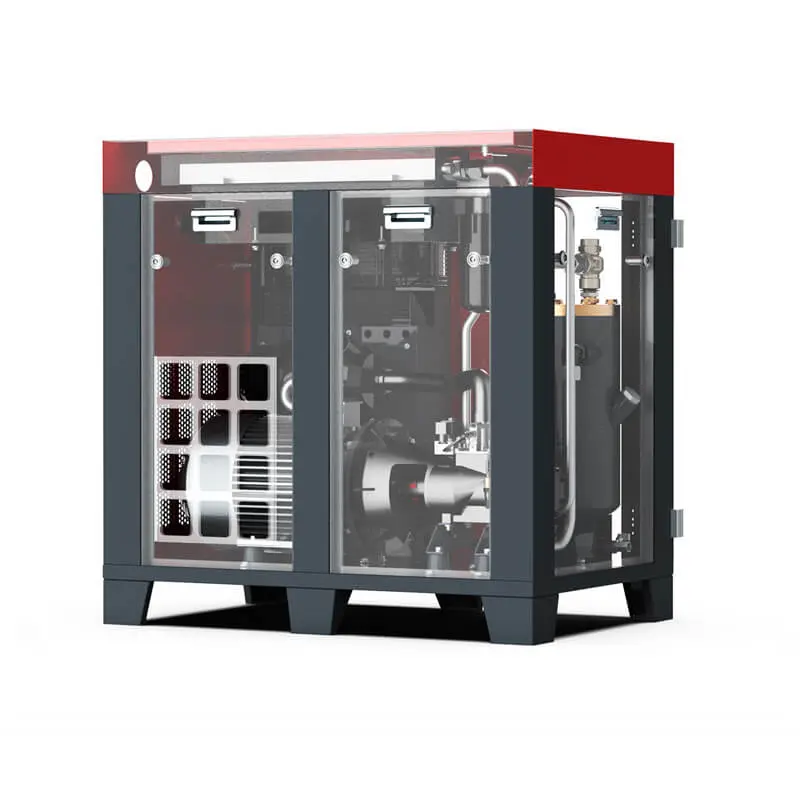
Cooling Compressed Air
Your screw compressor heats air as it compresses it. You need to cool this air before you use it. Cooling protects your tools and keeps your system safe. Most rotary screw compressors use two main cooling methods:
-
Air-cooled systems use fans to blow ambient air over the aftercooler. This lowers the temperature of compressed air to about 15-20°F above the room temperature. These systems work well for most jobs.
-
Water-cooled systems use circulating water to absorb heat. These systems cool the air to 10-15°F above the water temperature. You often see water-cooled systems in places that need a lot of compressed air.
You should keep your compressor in a space with temperatures between 50°F and 85°F. High temperatures can cause overheating. Dirty or clogged aftercoolers also reduce airflow and cooling. Low oil levels in oil-injected compressors make cooling less effective. If you notice your compressor running hot, check the cooling system first.
Tip: Clean the aftercooler and check oil levels often. This helps prevent overheating and keeps your compressor working well.
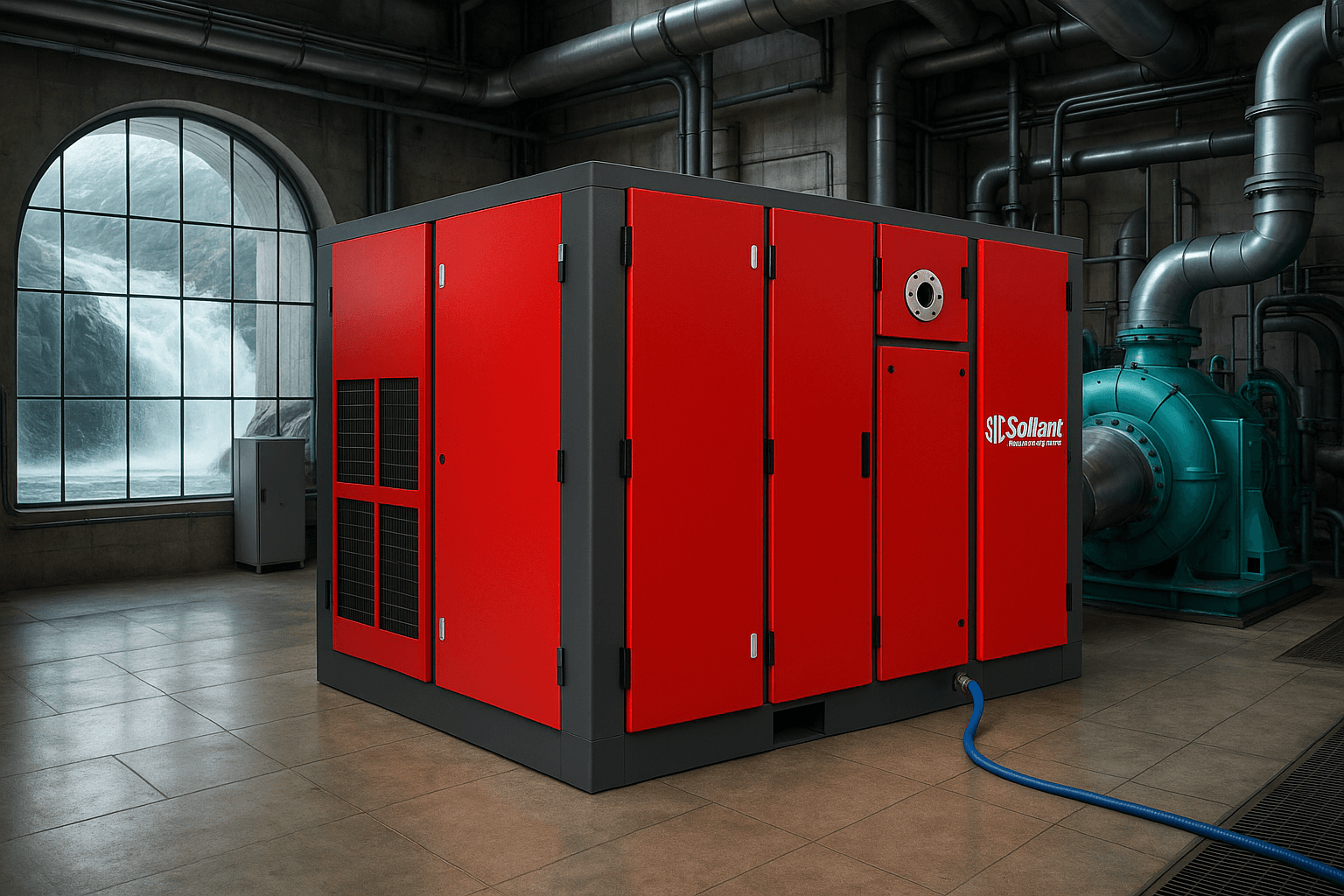
Air Outlet
After cooling, your screw compressor sends the compressed air to your equipment. The process follows these steps:
-
Air enters through the intake.
-
The regulator valve sets the pressure and directs air into the compression chamber.
-
The motor spins the helical screws, compressing the air.
-
Compressed air leaves the chamber and passes through the aftercooler.
-
The system dries and filters the air to remove moisture and dirt.
-
Clean, dry air goes to your tools or stores in an air receiver tank.
You get reliable air for your machines. Clean air helps your equipment last longer and work better.
Energy Efficiency
You save energy when you use a screw compressor. These machines use less power than reciprocating compressors. You spend less money over time, even if the initial cost is higher. Efficient cooling and delivery systems help you avoid wasted energy. If you keep your compressor clean and well-maintained, you get the best performance and lowest energy bills.
Note: Rotary screw compressors offer long-term savings and steady performance. You make a smart choice for your business by choosing energy-efficient equipment.
You can understand the operation of a screw compressor by following these steps:
-
Compress air with helical rotors.
-
Separate oil from air for clean output.
-
Cool the compressed air.
-
Deliver air for use or storage.
-
Recycle oil and save energy.
You get a steady flow of compressed air with fewer moving parts, which means less maintenance and reliable performance. Regular checks and new technology help you keep your compressor efficient every day.
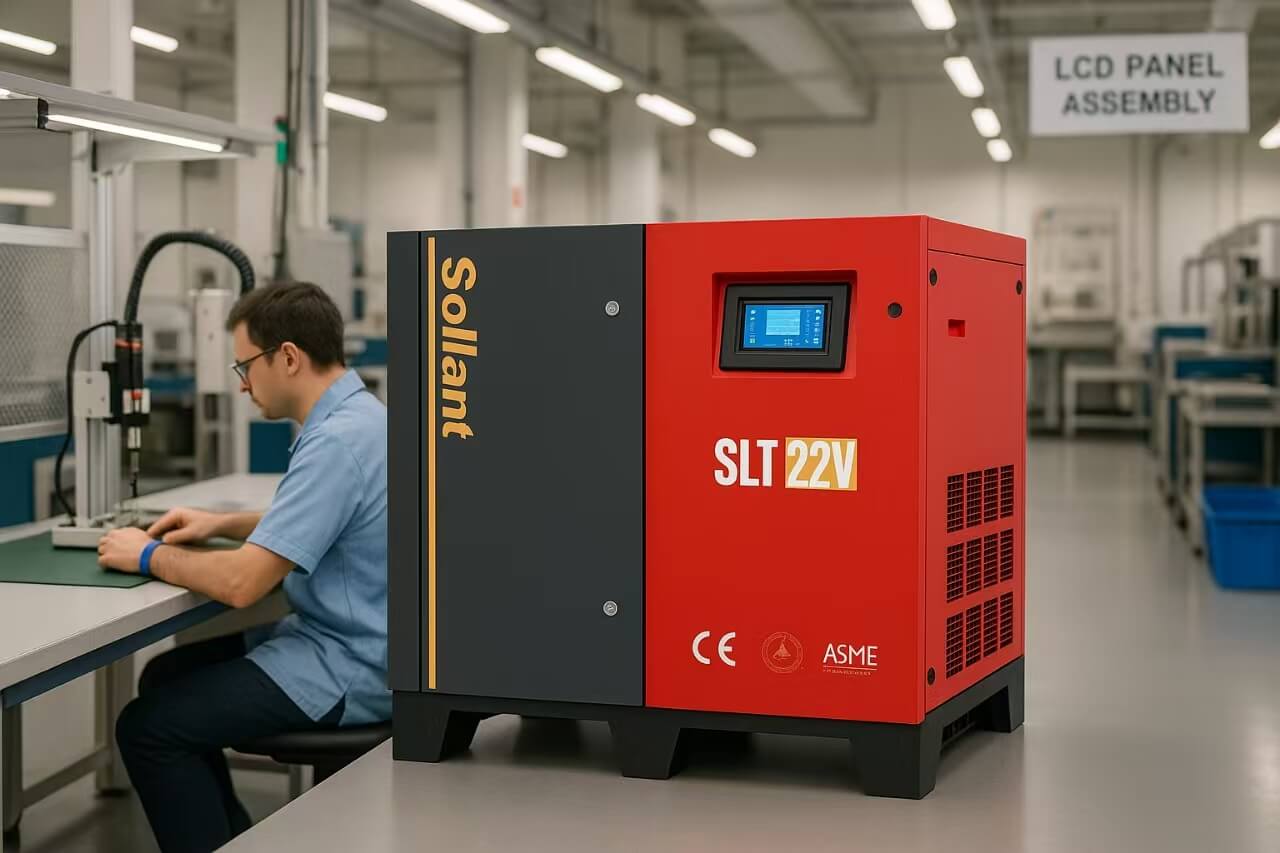
FAQ
What maintenance does a rotary screw compressor need?
You should check oil levels, clean filters, and inspect belts often. Replace the oil and filters as recommended. Clean the coolers and drain condensate daily. Regular maintenance helps your compressor run smoothly and last longer.
How long does a rotary screw compressor last?
You can expect a rotary screw compressor to last 10 to 15 years with proper care. Good maintenance and using the right oil extend its life. Always follow the manufacturer’s service schedule.
Can you use a rotary screw compressor for continuous operation?
You can run a rotary screw compressor nonstop. It works well for long shifts and heavy use. The design allows for steady air delivery without overheating. This makes it ideal for factories and workshops.
What is the difference between oil-injected and oil-free screw compressors?
|
Feature |
Oil-Injected |
Oil-Free |
|---|---|---|
|
Lubrication |
Uses oil |
No oil used |
|
Maintenance |
Needs oil changes |
Less maintenance |
|
Air Purity |
May have oil vapor |
Clean, dry air |
Why does the compressor need cooling?
You need cooling because compressing air creates heat. Cooling protects your tools and keeps the compressor safe. Air-cooled and water-cooled systems lower the temperature so you get reliable, safe compressed air.


